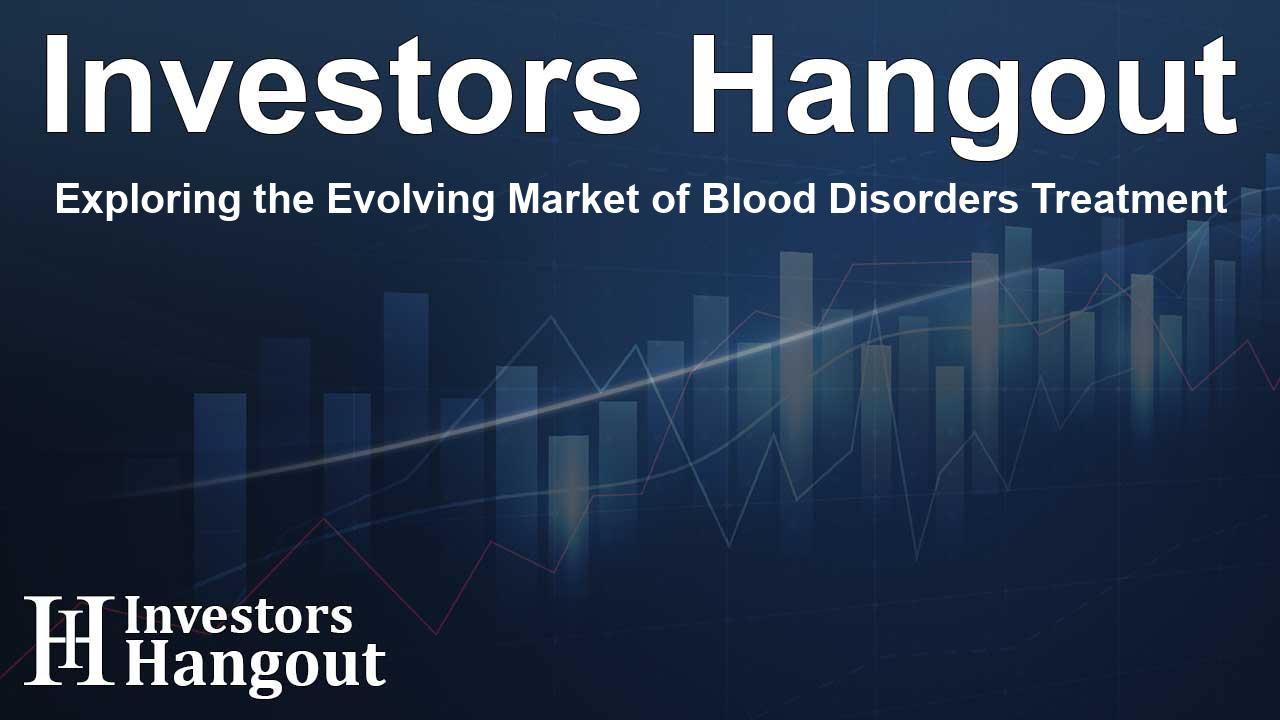Exploring the Evolving Market of Blood Disorders Treatment

Understanding Blood Disorders
Blood disorders impact millions around the globe, with around 5% of the population affected by conditions such as anemia. This silent epidemic is responsible for more than 2 billion individuals worldwide experiencing blood-related health challenges, often stemming from iron deficiency or chronic illness. The realm of treatment is advancing significantly, leveraging targeted therapies and cutting-edge gene-editing innovations.
Blood disorders can drastically affect the production and functioning of blood cells, causing serious health issues. These conditions include anemia, which denotes a lack of red blood cells or hemoglobin, leading to fatigue and weakness, as well as thrombocytopenia, characterized by a deficient number of platelets, potentially resulting in excessive bleeding. Various factors contribute to these disorders: genetic predispositions, autoimmune responses, infections, and environmental influences. Treatment protocols vary based on specific conditions, employing medications, blood transfusions, or even bone marrow transplants.
Recently, a series of reports focusing on blood disorders, notably Immune Thrombocytopenia, Aplastic Anemia, and Diamond-Blackfan Anemia, were released. These comprehensive studies offer insights into current treatment methods, emerging pharmaceuticals, market shares of therapies, and projected market growth from 2020 to 2034 in the 7MM (which encompasses the United States, EU-4 nations, the United Kingdom, and Japan).
Market Overview of Immune Thrombocytopenia
Immune thrombocytopenic purpura (ITP) is characterized by a low platelet count due to an autoimmune response, leading to bruising and bleeding. This condition often presents acutely in children but can become chronic in adults. Treatment approaches primarily consist of corticosteroids, intravenous immunoglobulin (IVIg), and rituximab.
Among the 7MM, the United States reports the highest incidence of ITP, with approximately 66,500 affected individuals in 2023. Primary ITP, constituting around 80% of all cases, occurs independently of other diseases, while secondary ITP occurs in about 20% of cases in conjunction with conditions like systemic lupus erythematosus or due to certain medications.
The treatment protocol for ITP typically begins with steroids, with prednisone administered at a rate of 1 mg/kg/day for 21 to 28 days, followed by a tapering schedule. Higher doses of dexamethasone might induce a more significant platelet response. For urgent situations, options like IVIG and anti-D immune globulin can prompt rapid platelet increases.
In cases where patients do not respond to initial treatments, second-line therapies are considered. IVIG has shown effectiveness in 70-80% of cases, while anti-D is effective in 50-70% of RhD-positive patients. Splenectomy remains a traditional but risky second-line treatment choice due to potential complications like infection.
Rituximab, targeting the CD20 protein expressed on B-cells, exhibits substantial efficacy in managing ITP, both post and pre-splenectomy. Thrombopoietin-receptor agonists, such as romiplostim and eltrombopag, stand out as effective alternatives that stimulate platelet production by activating the thrombopoietin receptor.
In terms of market dynamics, the total ITP market size across the 7MM was around USD 3.1 billion in 2023. Among available treatments, PROMACTA (eltrombopag) generated the highest revenue, and with an increase in ITP cases, the market is projected to expand further due to the introduction of new therapies throughout the upcoming years (2024-2034).
Aplastic Anemia Market Insights
Aplastic anemia, a severe non-cancerous disorder, entails the autoimmune destruction of early hematopoietic cells, leading to a diminished number of blood cells. Global incidence rates range between 0.7 to 7.4 cases per million annually, with a notably higher prevalence in Asian countries compared to European and American regions.
DelveInsight estimates suggest that the total incidence of aplastic anemia in the 7MM was approximately 2,500 cases in 2023, a figure expected to rise in the future. Severe and very severe patients comprise about 65%-80% of the total patient population.
Hematopoietic stem cell transplantation (HSCT) remains the standard treatment for younger patients under 40, while immunosuppressive therapies are recommended for those aged 40 and above. The leading pharmacological treatment is currently PROMACTA/REVOLADE, which substantially drives revenue alongside immunosuppressive therapies across the market.
According to Novartis, revenue from PROMACTA/REVOLADE primarily stems from its application in patients facing chronic ITP and severe aplastic anemia (SAA). Launched first in the United States in 2014 for relapsed/refractory SAA patients and followed by approvals in Europe and Japan, it has expanded treatment options significantly.
The total market for aplastic anemia reached an approximate ~USD 270 million in 2023 in the 7MM, expected to grow due to rising disease incidences, the increasing uptake of PROMACTA, new product approvals, and the expected launch of emerging therapies.
Diamond-Blackfan Anemia Overview
Diamond-Blackfan anemia (DBA) is a rare genetic disorder that affects the bone marrow's ability to produce red blood cells, resulting in severe anemia. Typically diagnosed in infancy or early childhood, patients often exhibit symptoms such as pale skin, fatigue, stunted growth, and sometimes physical defects such as thumb abnormalities or heart issues.
In 2023, the estimated number of DBA cases across the 7MM was around 7,870, with about 70% of these cases in the United States. Notably, approximately 46% of all DBA cases correspond to mutations in the RPS19 gene, which is essential for ribosomal protein synthesis.
Although DBA affects overall health significantly, there are currently no FDA-approved treatments for this condition. Management often focuses on using corticosteroids, chronic blood transfusions, iron chelation, and potentially curative HSCT.
For 2023, the total market value for Diamond-Blackfan anemia was USD 1.56 million, with growth anticipated through 2034. The U.S. market holds a dominant share compared to the EU4, the UK, and Japan. As of 2023, corticosteroids lead the treatment market with around USD 1.1 million in revenues, highlighting an essential first-line treatment option. With no emerging therapies in the pipeline, innovative solutions such as gene therapy could significantly impact DBA patient care.
Frequently Asked Questions
What are the primary blood disorders covered in the market reports?
The reports focus on Immune Thrombocytopenia, Aplastic Anemia, and Diamond-Blackfan Anemia.
What are the current treatment options for Immune Thrombocytopenia?
Current treatments include corticosteroids, IVIg, rituximab, and thrombopoietin-receptor agonists.
How is Aplastic Anemia typically treated?
Treatment options include HSCT for those under 40 and immunosuppressive therapies for older patients.
Are there any FDA-approved treatments for Diamond-Blackfan Anemia?
No, there are currently no FDA-approved therapies specifically for Diamond-Blackfan Anemia.
What is the market size for Immune Thrombocytopenia in 2023?
The market size for Immune Thrombocytopenia was approximately USD 3.1 billion in 2023.
About The Author
Contact Olivia Taylor privately here. Or send an email with ATTN: Olivia Taylor as the subject to contact@investorshangout.com.
About Investors Hangout
Investors Hangout is a leading online stock forum for financial discussion and learning, offering a wide range of free tools and resources. It draws in traders of all levels, who exchange market knowledge, investigate trading tactics, and keep an eye on industry developments in real time. Featuring financial articles, stock message boards, quotes, charts, company profiles, and live news updates. Through cooperative learning and a wealth of informational resources, it helps users from novices creating their first portfolios to experts honing their techniques. Join Investors Hangout today: https://investorshangout.com/
The content of this article is based on factual, publicly available information and does not represent legal, financial, or investment advice. Investors Hangout does not offer financial advice, and the author is not a licensed financial advisor. Consult a qualified advisor before making any financial or investment decisions based on this article. This article should not be considered advice to purchase, sell, or hold any securities or other investments. If any of the material provided here is inaccurate, please contact us for corrections.
